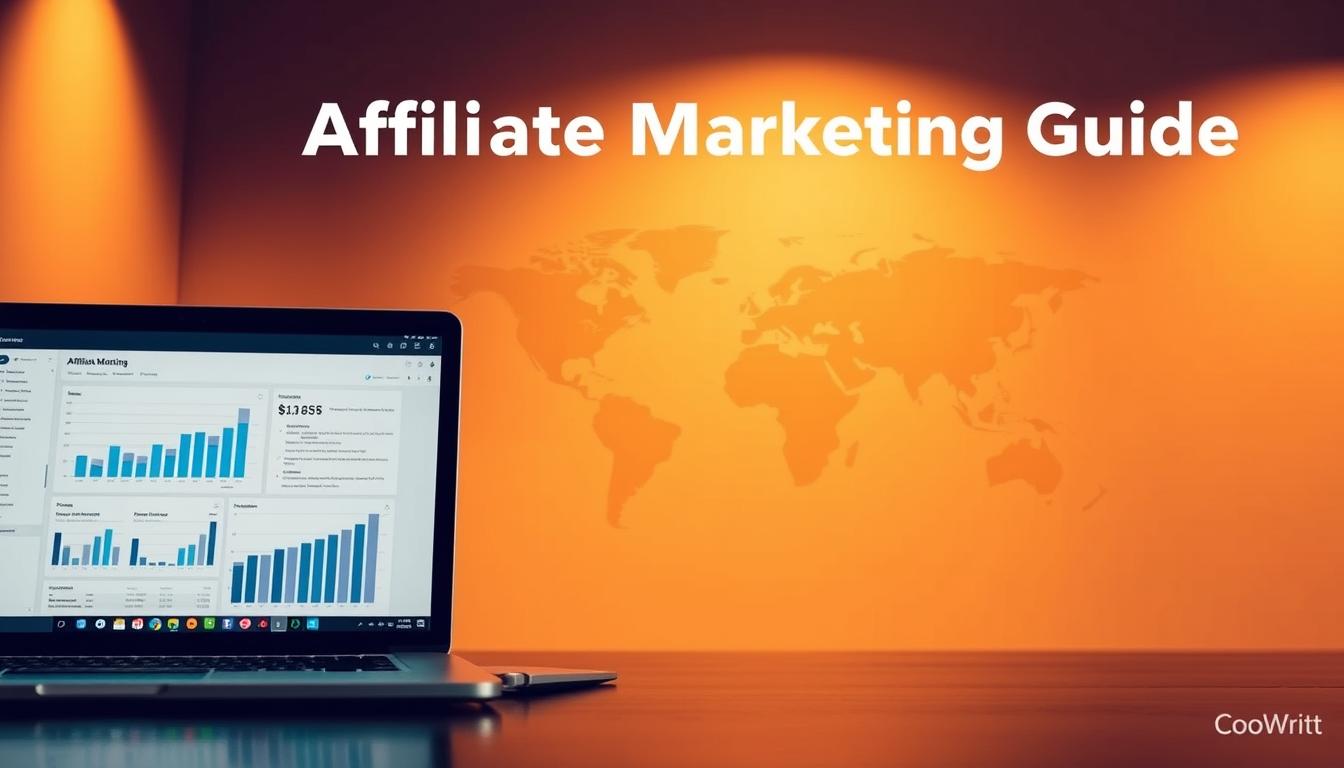Are you looking for a way to generate income online with minimal upfront investment? Affiliate marketing might be the perfect solution. This business model allows you to earn commissions by promoting products or services through unique referral links. It’s a win-win for both you and the companies you partner with.
Affiliate marketing is scalable and accessible, making it ideal for beginners. Whether you have a blog, social media presence, or website, you can start promoting products to your audience. The global affiliate marketing industry is growing rapidly, offering endless opportunities for success.
In this guide, we’ll walk you through every step, from choosing a niche to developing a winning strategy. With the right tools and tips, you can turn this opportunity into a steady stream of passive income. Let’s get started on this exciting journey together!
Key Takeaways
- Affiliate marketing is a low-cost way to earn income online.
- You earn commissions by promoting products through unique links.
- It’s a scalable model suitable for beginners.
- The global affiliate marketing industry is growing rapidly.
- This guide provides tools, tips, and strategies for success.
Introduction to Affiliate Marketing: The Basics
Curious about a business model that rewards you for promoting great products? Affiliate marketing is a simple yet powerful way to earn commissions by sharing products or services with your audience. It’s a win-win for both you and the companies you partner with.
What Affiliate Marketing Is All About
At its core, affiliate marketing is a performance-based strategy. You promote a product or service using a unique referral link. When someone clicks your link and makes a purchase, you earn a commission. No need to create your own products or handle customer service.
This model is ideal for beginners because it’s low-cost and scalable. Whether you run a blog, social media account, or website, you can start earning by sharing products your audience will love. The best part? You can grow your income as your audience grows.
Why It’s a Win-Win for Marketers and Companies
Affiliate marketing benefits both parties. Companies gain exposure and sales without upfront marketing costs. You earn commissions for driving those sales. It’s a partnership built on mutual success.
Here’s how it works in practice:
- Product Reviews: Share honest reviews on your blog or YouTube channel.
- Social Media Promotion: Highlight products your followers might enjoy.
- Email Campaigns: Recommend products to your subscribers.
With low start-up costs and the potential for passive income, affiliate marketing is a smart choice for anyone looking to earn online. Plus, you don’t need to create your own products to get started. Simply find a niche you’re passionate about and start promoting.
Ready to dive in? Let’s explore how you can turn this opportunity into a steady stream of income.
Understanding Affiliate Marketing and Its Benefits
Want to build a sustainable online income without heavy investments? Affiliate marketing offers a flexible and scalable way to earn money by promoting products you believe in. With minimal start-up costs and the potential for passive income, it’s a model that grows with your audience.
Low Start-Up Costs and Scalability
One of the biggest advantages of this business model is its low barrier to entry. You don’t need to create your own products or manage inventory. Instead, you partner with brands and earn a commission for every purchase made through your unique link.
As your audience grows, so does your earning potential. For example, a blogger with 10,000 monthly visitors can scale their operations by promoting multiple products or expanding into new niches. Tools like Google Analytics help track performance, ensuring your strategy evolves with your audience’s needs.
The Power of Passive Income
Imagine earning money while you sleep. That’s the beauty of passive income. Once you create content—like a blog post or video—it continues to generate clicks and sales over time. For instance, a well-written product review can drive purchases for months or even years.
Here’s a breakdown of how this model works:
| Step | Action | Outcome |
|---|---|---|
| 1 | Choose a product to promote | Align with your audience’s interests |
| 2 | Share your unique affiliate link | Drive traffic to the product page |
| 3 | Earn a commission on each sale | Build a steady stream of income |
With the right strategy, you can turn this opportunity into a thriving online business. Start small, stay consistent, and watch your efforts pay off.
Affiliate Marketing 101: A Beginner’s Guide to Earning Passive Income Online
Ready to explore a simple way to earn online with minimal effort? This section is your core guide tailored for beginners. We’ll walk you through the step-by-step process, from learning the basics to executing strategies that work.
One of the biggest advantages of this model is its low barrier to entry. You don’t need to create your own products or manage inventory. Instead, you partner with brands and earn a commission for every purchase made through your unique link.
| Step | Action | Outcome |
|---|---|---|
| 1 | Choose a niche you’re passionate about | Align with your audience’s interests |
| 2 | Join a reputable affiliate program | Gain access to products and tools |
| 3 | Create content (blog posts, videos, etc.) | Drive traffic to your affiliate links |
| 4 | Track performance and optimize | Maximize your earnings over time |
Passive income is a major benefit of this model. Once you create content, it continues to generate clicks and sales. For example, a well-written product review can drive purchases for months or even years.
“Affiliate marketing is not just about earning; it’s about building trust with your audience.”
Real-life examples from programs like Amazon Associates and ShareASale show how beginners can succeed. These platforms offer a wide range of products to promote, making it easy to find something that fits your niche.
In the upcoming sections, we’ll dive deeper into choosing the right niche, selecting profitable programs, and developing a winning strategy. Stay tuned for detailed tools, tips, and trends to help you succeed.
Choosing the Right Niche for Your Affiliate Journey
Starting your affiliate journey begins with choosing the right niche. A well-selected niche aligns with your passion and meets market demand, setting the foundation for success. Let’s explore how to identify the perfect fit for your efforts.
Identifying Your Passion and Expertise
Your niche should reflect your interests and expertise. When you’re passionate about a topic, creating content feels natural and authentic. For example, if you love travel, promoting travel gear or booking platforms can be a great fit.
Think about your hobbies, skills, and experiences. What topics excite you? What knowledge can you share with your audience? Aligning your niche with your passion ensures long-term motivation and credibility.
Evaluating Market Demand
Passion alone isn’t enough; your niche must also have market demand. Use tools like Google Trends and keyword research to identify trending topics. Look for niches with consistent search volume and growth potential.
For instance, the health and wellness industry continues to grow, offering opportunities for affiliates. Similarly, technology and personal finance are lucrative areas with high consumer interest.

| Niche | Market Demand | Example Products |
|---|---|---|
| Travel | High, especially post-pandemic | Luggage, booking platforms |
| Technology | Consistently growing | Gadgets, software |
| Health & Wellness | Steady increase | Supplements, fitness gear |
Aligning your passion with market demand increases trust among your audience. When you genuinely believe in the products you promote, your recommendations feel authentic. This builds stronger connections and drives better results.
Here are practical steps to research and validate your niche:
- Analyze Competitors: Study successful affiliates in your chosen niche. What strategies are they using?
- Test the Waters: Start small by promoting a few products. Monitor engagement and sales to gauge interest.
- Engage with Your Audience: Ask your followers what they’re interested in. Their feedback can guide your niche selection.
Choosing the right niche is a critical step in your affiliate journey. It ensures your content resonates with your audience and maximizes your earning potential. Take the time to explore your options and find the perfect match for your passion and expertise.
Selecting Profitable Affiliate Programs
Finding the right affiliate programs can make or break your online business. The key is to choose programs that align with your niche and offer strong commission structures. Let’s explore how to identify the best options for your strategy.
Key Criteria and Commission Structures
When evaluating programs, consider factors like commission rates, payment frequency, and support. For example, Amazon Associates offers a tiered commission structure, while ShareASale provides a wide range of products with competitive rates. Look for programs that fit your audience’s needs and your promotional style.
Commission rates can vary widely, from 5% to 50% or more. Some programs also offer recurring commissions for subscription-based products. This can be a game-changer for long-term income. Always read the fine print to understand how and when you’ll get paid.
Where to Find Trusted Affiliate Networks
Reputable networks like Commission Junction and Rakuten Marketing are great starting points. These platforms vet their partners, ensuring you promote high-quality products. Partnering with well-known brands also boosts your credibility with your audience.
Here’s a quick checklist to assess a program’s legitimacy:
- Product Quality: Promote products you believe in and that align with your niche.
- Support and Resources: Look for programs that offer marketing materials and responsive support.
- Payment Terms: Ensure the program pays on time and has a reasonable payout threshold.
“The right program doesn’t just pay well—it helps you build trust with your audience.”
Thorough research is essential to avoid deceptive programs. Use reviews and forums to gather insights from other affiliates. For more tips on scaling your efforts, check out our guide on growing your affiliate marketing business.
By selecting the right programs, you set yourself up for success. Take the time to compare options and choose partners that align with your goals. With the right strategy, you can maximize your earnings and build a sustainable online business.
Developing a Robust Affiliate Marketing Strategy
A strong strategy is the backbone of any successful affiliate marketing effort. Without a clear plan, it’s easy to lose focus and miss opportunities. We’ll guide you through creating a strategy that drives results and maximizes your potential.
Mapping Out Your Content Plan
Consistency is key in affiliate marketing. A well-structured content plan ensures you’re regularly engaging your audience and promoting products effectively. Start by identifying the types of content that resonate with your audience, such as blog posts, videos, or social media updates.
Here’s how to build a content calendar:
- Set Goals: Define what you want to achieve with each piece of content.
- Plan Ahead: Schedule posts in advance to maintain consistency.
- Track Performance: Use analytics to see what’s working and adjust your plan accordingly.

Integrating SEO best practices into your content plan can boost organic traffic. Focus on keyword research, meta descriptions, and high-quality backlinks. This approach ensures your content ranks well and attracts the right audience.
Strategic Platform Selection
Choosing the right platforms is crucial for reaching your target audience. Whether it’s a blog, YouTube channel, or social media, each platform has unique strengths. For example, blogs are great for in-depth reviews, while Instagram excels at visual storytelling.
Consider these factors when selecting platforms:
- Audience Preferences: Where does your audience spend most of their time?
- Content Format: Does the platform support the type of content you create?
- Engagement Potential: How easily can you interact with your audience?
Combining multiple platforms can amplify your reach. For instance, use your blog to drive traffic to your affiliate links and social media to build relationships with your audience. This measured approach ensures you’re maximizing every opportunity.
“The right strategy doesn’t just boost sales—it builds trust and long-term relationships with your audience.”
By developing a personalized strategy, you set yourself up for success in affiliate marketing. Start with a clear plan, stay consistent, and watch your efforts pay off.
Creating an Engaging Website or Blog
Your website or blog is the foundation of your affiliate efforts. It’s where your audience connects with your content and discovers the products you promote. A well-designed site not only attracts visitors but also keeps them engaged, increasing the chances of conversions.
Design Principles for User Engagement
An attractive design is crucial for keeping visitors on your site. Focus on clean layouts, easy navigation, and visually appealing elements. Use contrasting colors for call-to-action buttons to make them stand out. Ensure your fonts are readable and consistent across all pages.
Seamless navigation is key. Visitors should find what they’re looking for within a few clicks. Organize your content into categories and use a search bar for quick access. A well-structured site keeps users engaged longer, boosting your chances of promoting products effectively.
SEO Best Practices for Organic Traffic
SEO is essential for driving organic traffic to your site. Start with keyword research to identify terms your audience is searching for. Incorporate these keywords naturally into your titles, headings, and content. Meta tags and descriptions also play a vital role in improving search engine visibility.
Responsive design is a must. With over half of web traffic coming from mobile devices, your site must look great on all screen sizes. Fast load times are equally important. Use tools like Google PageSpeed Insights to optimize your site’s performance.
“A well-optimized site doesn’t just attract visitors—it keeps them coming back.”
Visual content, like images and videos, enhances user experience. Use high-quality visuals that complement your written content. Clear call-to-actions guide visitors toward your affiliate links, increasing the likelihood of conversions.
By implementing these design and SEO principles, you can create a website or blog that engages your audience and drives traffic. Start building your online presence today and watch your affiliate efforts thrive.
Building and Nurturing Your Audience
Building a loyal audience is the cornerstone of success in affiliate marketing. Your audience is your most valuable asset, and nurturing it requires consistent effort and a thoughtful strategy. By engaging with your followers and creating a sense of community, you can foster trust and loyalty, which directly translates into higher conversions.

Effective Social Media Engagement
Social media is a powerful tool for connecting with your audience. Platforms like Instagram, Facebook, and Twitter allow you to share content, interact with followers, and promote products seamlessly. To maximize engagement, focus on creating posts that resonate with your audience’s interests and encourage interaction.
Here are some proven strategies:
- Post Consistently: Regular updates keep your audience engaged and coming back for more.
- Use Visuals: High-quality images and videos grab attention and make your content more shareable.
- Engage Actively: Respond to comments, answer questions, and participate in conversations to build relationships.
Community Building and Relationship Management
Beyond social media, building a dedicated community can strengthen your affiliate efforts. Email newsletters, forums, and exclusive groups are excellent ways to keep your audience engaged. These platforms allow for deeper connections and personalized communication.
Here’s how to manage relationships effectively:
- Personalize Communication: Address your audience by name and tailor content to their preferences.
- Offer Value: Share tips, insights, and exclusive offers to keep your audience interested.
- Be Responsive: Quick replies to inquiries or feedback show that you value your audience’s input.
“A loyal audience doesn’t just boost sales—it builds a foundation for long-term success.”
Continuous audience analysis is essential. Use tools like Google Analytics to understand your audience’s behavior and preferences. This data helps you refine your content and promotions, ensuring they align with your audience’s needs.
By focusing on engagement and community building, you can create a loyal audience that supports your affiliate marketing efforts. Start implementing these strategies today and watch your relationships—and revenue—grow.
Crafting Content That Converts
Crafting content that drives action is essential for success in affiliate marketing. High-quality, authentic content not only engages your audience but also persuades them to take the next step. Whether it’s a product review or a how-to guide, your content should provide value and build trust.
Writing Authentic Product Reviews
Authentic product reviews are a cornerstone of effective affiliate marketing. Readers trust honest opinions, so always share your genuine experience with the product. Start by highlighting its features, benefits, and any drawbacks. This transparency builds credibility and helps your audience make informed decisions.
Here are some best practices for writing compelling reviews:
- Be Honest: Share both the pros and cons of the product.
- Include Personal Experience: Describe how the product worked for you or your audience.
- Use Visuals: Add images or videos to showcase the product in action.
Developing How-To Guides and Tutorials
How-to guides and tutorials are powerful tools for driving conversions. They provide step-by-step instructions that solve a problem or teach a skill. Start by identifying a common challenge your audience faces, then create a guide that addresses it.
Here’s how to structure your tutorials for maximum engagement:
- Start with a Clear Objective: Explain what the guide will achieve.
- Break It Down: Use numbered steps or bullet points for easy readability.
- Include Visuals: Screenshots, diagrams, or videos make the guide more user-friendly.
“Great content doesn’t just inform—it inspires action.”
Finally, always include a clear call-to-action. Whether it’s encouraging readers to try the product or share the guide, make the next step obvious. By focusing on quality and authenticity, you can create content that converts and builds lasting relationships with your audience.
Effective Product Promotion Techniques
Discover innovative ways to promote products that resonate with your audience while maintaining authenticity. The key is to blend creativity with transparency, ensuring your audience feels valued rather than pressured. Let’s explore some proven techniques to elevate your promotional efforts.
Sponsorship and Native Advertising
Sponsorships and native advertising are powerful tools for subtly promoting products. These methods integrate promotions seamlessly into your content, making them feel less intrusive. For example, a sponsored blog post or a native ad within a video can naturally highlight a product’s benefits.
Transparency is crucial. Always disclose sponsorships and affiliate links to build trust with your audience. A simple disclaimer like “This post contains affiliate links” ensures honesty and compliance with regulations.

Successful campaigns often use storytelling to engage the audience. For instance, a fitness influencer might share their personal journey with a sponsored product, making the promotion feel authentic and relatable.
Using Call-to-Actions Creatively
Call-to-actions (CTAs) are essential for driving clicks and sales, but they don’t have to be pushy. Instead of generic phrases like “Buy Now,” try something more engaging, such as “Discover How This Product Can Transform Your Routine.”
Here are some creative ways to incorporate CTAs:
- Embed CTAs in Stories: Share a personal experience and end with a natural CTA.
- Use Visual Cues: Highlight CTAs with buttons or banners that blend with your design.
- Offer Value: Pair CTAs with exclusive discounts or free resources to incentivize action.
Tracking clicks and sales helps refine your CTAs over time. Use analytics to identify which phrases and placements perform best, then optimize accordingly.
“The best promotions don’t feel like promotions—they feel like valuable recommendations.”
Diverse strategies work best across different platforms. For example, Instagram thrives on visual CTAs, while blogs benefit from in-depth reviews with embedded links. By balancing high-quality content with promotional tactics, you can build trust while driving sales.
For more insights on creating effective affiliate marketing websites, explore our comprehensive guide.
Leveraging Affiliate Marketing Tools and Plugins
Streamlining your affiliate efforts with the right tools can make all the difference. Whether you’re managing links, tracking performance, or optimizing your strategy, the right plugins and software can save time and boost results. Let’s explore some essential tools that can simplify your workflow and enhance your success.
Top Tools for Link Management and Tracking
Managing affiliate links can be overwhelming, especially as your content grows. Tools like ThirstyAffiliates and Pretty Links make it easy to organize and cloak your links. These plugins also monitor link health, ensuring your promotions remain active and effective.
For those running WordPress sites, AffiliateWP is a powerful option. It integrates seamlessly with your blog, automating tasks like commission tracking and payouts. These tools not only save time but also provide valuable insights into your link performance.
Analytics and Performance Optimization
Understanding your audience’s behavior is key to refining your strategy. Tools like Google Analytics help track metrics such as clicks, conversions, and bounce rates. This data allows you to identify what’s working and where to improve.
Here’s a quick comparison of popular tools:
| Tool | Key Feature | Best For |
|---|---|---|
| ThirstyAffiliates | Link cloaking and organization | Link management |
| Pretty Links | Link tracking and redirection | Performance monitoring |
| AffiliateWP | Commission tracking | WordPress integration |
| Google Analytics | Audience insights | Strategy optimization |
Using these tools, you can create a centralized dashboard to monitor all your affiliate metrics. This approach not only boosts productivity but also helps you make data-driven decisions.
“The right tools don’t just simplify tasks—they unlock new opportunities for growth.”
Experiment with different plugins to find the best fit for your needs. By leveraging these resources, you can streamline your efforts and maximize your revenue potential. Start exploring today and take your affiliate strategy to the next level.
Maximizing Your Passive Income Potential
Looking to expand your earnings beyond traditional methods? Diversifying your income streams can unlock new opportunities. By exploring alternative monetization strategies and optimizing your current efforts, you can significantly boost your revenue. Let’s dive into actionable ways to maximize your potential.
Diversifying Revenue Streams
Relying solely on traditional affiliate links can limit your earning potential. Integrating additional methods like digital products, consulting, or even creating your own courses can provide multiple income sources. For example, a fitness blogger might sell workout plans alongside promoting gym equipment.
Here’s how to diversify effectively:
- Create Digital Products: E-books, templates, or online courses can generate recurring revenue.
- Offer Consulting Services: Share your expertise through one-on-one sessions or group workshops.
- Expand Your Content: Use high-performing blog posts or videos to promote multiple products.
Strategies to Boost Commission Rates
Negotiating better commission rates with affiliate partners can significantly increase your earnings. Start by building a strong relationship with the brands you promote. Demonstrate your value by showcasing your traffic, engagement, and conversion rates.
Here’s a comparison of commission rates across popular niches:
| Niche | Average Commission Rate |
|---|---|
| Health & Wellness | 20% – 50% |
| Technology | 5% – 15% |
| Fashion | 10% – 20% |
| E-commerce | 5% – 10% |
Additionally, focus on promoting high-ticket items or subscription-based products. These often offer higher commissions and recurring income. For instance, software subscriptions can provide steady payouts over time.
“Diversification doesn’t just increase income—it minimizes risk and creates stability.”
Experiment with new programs and revenue models to find what works best for your audience. By combining multiple strategies, you can build a sustainable and profitable online business.
Building Trust and Transparency with Your Audience
Building trust with your audience is the foundation of long-term success in affiliate marketing. Without honesty and transparency, even the best strategies can fall flat. When your audience feels confident in your recommendations, they’re more likely to engage and make purchases.
Honest Disclosures and Affiliate Link Best Practices
Transparency starts with clear disclosures. Always let your audience know when you’re using affiliate links. A simple statement like “This post contains affiliate links” can go a long way in building trust. It shows you value their trust over quick profits.
Here are some best practices for handling affiliate links:
- Place Disclosures Prominently: Ensure they’re visible and easy to find.
- Be Consistent: Use the same disclosure language across all platforms.
- Explain the Process: Briefly describe how affiliate links work to educate your audience.
Honesty isn’t just ethical—it’s also effective. Studies show that 90% of consumers trust recommendations from people they know. By being transparent, you position yourself as a trusted advisor.
Sharing Personal Experiences Authentically
Personal stories add credibility to your promotions. When you share your own experiences with a product, it feels genuine and relatable. For example, if you’re promoting a fitness tracker, talk about how it helped you stay active.
Here’s how to make your experiences resonate:
- Be Specific: Share details about how the product solved a problem for you.
- Highlight Both Pros and Cons: No product is perfect, and acknowledging flaws builds trust.
- Use Visuals: Photos or videos of you using the product can make your story more compelling.
“Authenticity isn’t just about being honest—it’s about being human.”
By combining transparency with personal stories, you create a connection that goes beyond sales. Your audience will see you as a reliable source, leading to repeat visits and sustained engagement.
Remember, trust takes time to build but can be lost in an instant. Prioritize integrity in every recommendation, and your audience will reward you with loyalty and support.
Avoiding Common Pitfalls in Affiliate Marketing
Navigating the affiliate marketing landscape can be tricky, especially for newcomers. While the potential for earning is significant, there are common mistakes that can derail your efforts. By understanding these pitfalls, you can build a sustainable and ethical strategy.
Deceptive Tactics and How to Steer Clear
One of the biggest mistakes in affiliate marketing is using deceptive tactics. Overselling or misrepresenting a product can damage your credibility and alienate your audience. Always be honest about the products you promote, highlighting both their strengths and weaknesses.
Here are some deceptive practices to avoid:
- False Claims: Avoid exaggerating a product’s benefits or making promises it can’t deliver.
- Hidden Affiliate Links: Always disclose affiliate links clearly to maintain transparency.
- Spammy Content: Focus on creating valuable content rather than overloading your audience with promotions.
Learning from Industry Mistakes
Many beginners make the mistake of not reviewing their strategy regularly. Affiliate marketing is dynamic, and what works today might not work tomorrow. Use analytics to track your performance and make necessary adjustments.
Here’s a checklist to help you stay on track:
- Monitor Performance: Regularly review clicks, conversions, and audience engagement.
- Update Content: Keep your content fresh and relevant to maintain its effectiveness.
- Stay Ethical: Always prioritize your audience’s trust over short-term gains.
“The best strategies are built on honesty and continuous improvement.”
Learning from others’ mistakes can also save you time and effort. For example, many affiliates fail because they don’t diversify their income streams. Relying solely on one product or program can be risky. Explore multiple opportunities to create a stable income.
Finally, keep an open mindset. Feedback from your audience is invaluable. Use it to refine your approach and stay aligned with their needs. By avoiding these common pitfalls, you can build a successful and ethical affiliate marketing business.
Analyzing Trends and Future Outlook in Affiliate Marketing
The affiliate marketing landscape is evolving rapidly, offering new opportunities for growth and innovation. Staying ahead of these changes is crucial for long-term success. Let’s explore the current trends shaping the industry and what the future holds.
Current Trends Shaping the Industry
One of the most significant trends is the rise of influencer marketing. With 70% of consumers trusting recommendations from influencers, this strategy has become a cornerstone of affiliate efforts. Platforms like Instagram and YouTube are leading the way, enabling creators to connect with their audiences authentically.
Another trend is the increasing use of AI and automation. Tools like chatbots and predictive analytics are helping marketers optimize their campaigns and improve conversion rates. These technologies streamline processes, allowing affiliates to focus on creating high-quality content.
Market Projections and Future Opportunities
The affiliate marketing industry is projected to grow from $18.40 billion to an expected $56.29 billion in the coming years. This growth is driven by the increasing adoption of digital platforms and the expanding global audience. Emerging markets, in particular, present untapped potential for affiliates.
Here are some key opportunities to watch:
- Emerging Technologies: Blockchain and decentralized platforms could revolutionize how affiliate programs operate.
- Niche Markets: Specialized audiences, such as eco-conscious consumers, offer new avenues for targeted promotions.
- Mobile Optimization: With over half of web traffic coming from mobile devices, optimizing for mobile is essential.
“The future of affiliate marketing lies in innovation and adaptability. Staying informed about trends is key to sustained success.”
Consumer behavior is also shifting, with a growing preference for personalized experiences. Affiliates who can tailor their content to meet these demands will have a competitive edge. For example, using data analytics to understand audience preferences can lead to more effective campaigns.
As the industry continues to evolve, staying informed and adaptable will be critical. By leveraging emerging technologies and understanding market trends, affiliates can position themselves for long-term growth and success.
Integrating Additional Monetization Strategies
Expanding your revenue streams can significantly enhance your online business. While affiliate marketing is a powerful tool, relying solely on affiliate links may limit your earning potential. By integrating additional monetization strategies, you can create a more robust and sustainable income model.
Expanding Beyond Affiliate Links
Diversifying your income sources is key to long-term success. For example, selling digital products like e-books or online courses can provide recurring revenue. These products complement your affiliate efforts and offer value to your audience.
Here are some benefits of diversifying:
- Increased Revenue: Multiple income streams can boost your overall earnings.
- Reduced Risk: Relying on one source can be risky; diversification minimizes this.
- Enhanced Value: Offering additional products or services strengthens your relationship with your audience.
Exploring Digital Products and Consulting
Digital products and consulting services are excellent ways to expand your business. For instance, a fitness blogger might sell workout plans or offer personalized coaching. These strategies not only increase income but also establish you as an expert in your niche.
Here’s how to get started:
- Identify Your Expertise: Determine what skills or knowledge you can share.
- Create High-Quality Products: Ensure your digital products are valuable and well-designed.
- Market Effectively: Use your existing platforms to promote your new offerings.
“Diversification doesn’t just increase income—it creates stability and growth opportunities.”
By combining traditional affiliate marketing with new income models, you can build a more resilient business. Consistent effort and strategic planning are essential for maximizing your earnings. For more insights on affiliate marketing income potential, explore our comprehensive guide.
Experiment with different strategies to find what works best for your audience. The synergy between affiliate marketing and additional monetization methods can lead to greater success and financial stability.
Conclusion
Throughout this guide, we’ve explored the essential steps to succeed in affiliate marketing. From choosing the right niche to crafting engaging content, each strategy builds a foundation for sustainable growth. This model is accessible, scalable, and offers the potential for passive income, making it ideal for anyone starting their online journey.
By focusing on your audience’s needs and maintaining transparency, you can build trust and drive conversions. Tools and analytics help refine your strategy, ensuring long-term success. Remember, consistency and continuous learning are key to staying ahead in this dynamic industry.
Ready to take the next step? Start applying these actionable tips today and unlock new opportunities. For more insights, explore our effective affiliate marketing techniques to further enhance your strategy. Your affiliate journey begins now—embrace it with confidence!



